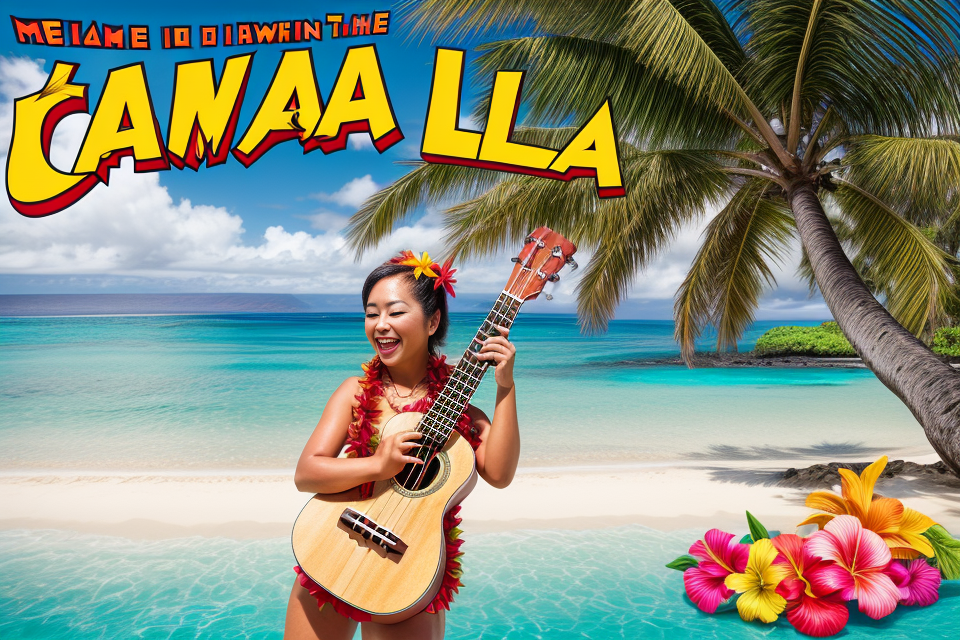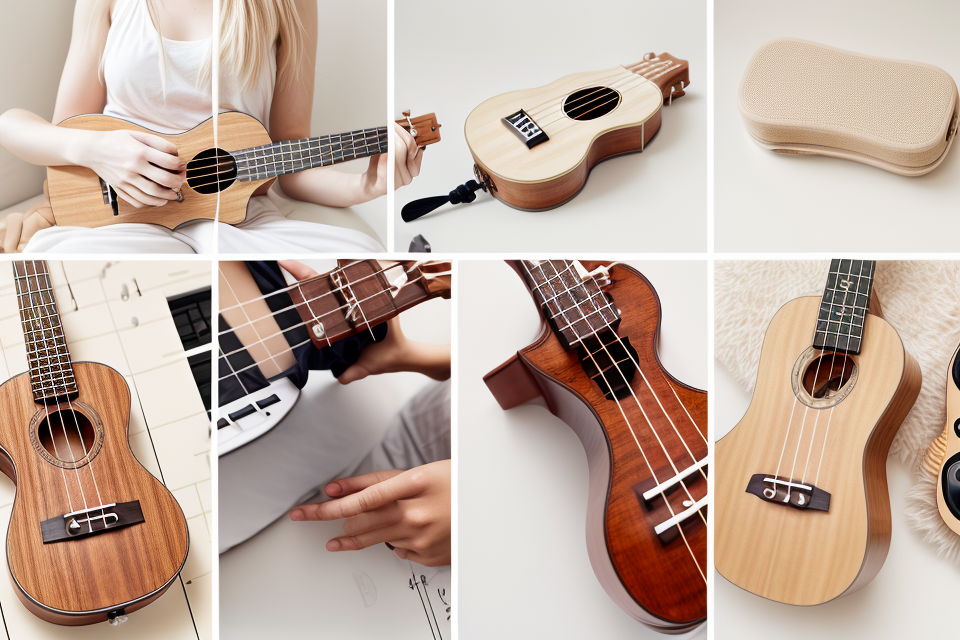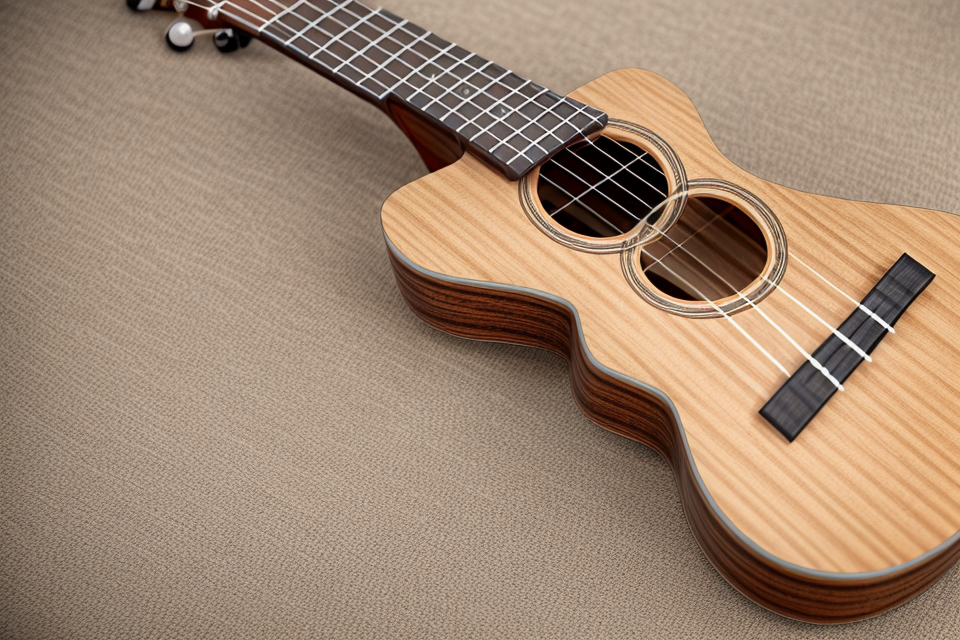The ukulele is a beloved instrument, cherished for its warm, inviting sound and playful nature. It has been embraced by musicians and music lovers around the world, but what do Hawaiians call this beloved instrument? Join us as we delve into the fascinating world of ukulele terminology and discover the answer to this intriguing question. Whether you’re a seasoned ukulele player or simply a curious music enthusiast, this exploration of the Hawaiian term for ukulele is sure to captivate and enlighten.
The Hawaiian term for ukulele is “uke.” The ukulele is a small, four-stringed instrument that originated in Hawaii in the late 19th century. It is traditionally made of koa wood and has a bright, cheerful sound that is often associated with Hawaiian music. The ukulele has become a popular instrument around the world and is played by people of all ages and skill levels.
The history of the ukulele in Hawaii
Origin of the ukulele
The origin of the ukulele can be traced back to the 1870s, when Portuguese immigrants introduced the instrument to the Hawaiian Islands. The ukulele is a small, four-stringed instrument, similar in size to a guitar, but with a distinctive shape and sound. It was initially called the “braguinha,” which was a small guitar-like instrument that was popular in Portugal.
The Hawaiian people quickly adopted the instrument and began to play it in their own unique style, incorporating local musical traditions and techniques. The Hawaiian musicians added their own distinctive rhythms and melodies to the instrument, and it soon became an integral part of Hawaiian music and culture.
The name “ukulele” was first used in the late 1800s, and it is derived from the Hawaiian words “uku,” which means “jumping,” and “lele,” which means “to dance.” The name refers to the lively, upbeat rhythms that are characteristic of Hawaiian music, and the ukulele is often associated with the joyful, carefree spirit of the islands.
Today, the ukulele remains an important part of Hawaiian music and culture, and it is played and enjoyed by people all over the world. Its unique sound and versatility have made it a popular choice for musicians of all genres, from folk to rock to jazz, and it continues to be a beloved instrument among players of all skill levels.
How it became popular in Hawaii
The ukulele has a rich history in Hawaii, and its popularity in the state can be traced back to the late 19th and early 20th centuries. It was introduced to Hawaii by Portuguese immigrants who came to work in the sugarcane fields. The instrument was initially used in Hawaiian music, but it soon became popular in other genres as well.
One of the main reasons for the ukulele’s popularity in Hawaii was its affordability. It was much cheaper than other instruments, such as the guitar or violin, and could be easily purchased by people of all ages and socioeconomic backgrounds. This made it an accessible instrument for many Hawaiians, who then shared their love for the ukulele with others.
Another factor that contributed to the ukulele’s popularity in Hawaii was its versatility. It could be played in a variety of styles, from traditional Hawaiian music to jazz and pop. This allowed musicians to incorporate the ukulele into a wide range of genres, making it a staple in Hawaiian music.
Additionally, the ukulele’s small size and portability made it an ideal instrument for street performers and buskers. This helped to spread the popularity of the ukulele throughout Hawaii and beyond, as people would hear it being played in public places and become interested in learning how to play themselves.
Overall, the ukulele’s affordability, versatility, and portability all contributed to its popularity in Hawaii. Today, the ukulele remains an important part of Hawaiian culture and music, and is enjoyed by people all over the world.
The different types of ukuleles
Soprano ukulele
The Soprano ukulele is the most common type of ukulele and is also the smallest. It is typically about 23 inches long and has a standard tuning of G-C-E-A. The Soprano ukulele is known for its bright and clear sound, making it a popular choice for beginners and professionals alike.
One of the defining features of the Soprano ukulele is its narrow neck, which makes it easy to hold and play for people of all ages and sizes. The Soprano ukulele also has a smaller body than other types of ukuleles, which makes it a great option for those who want a more portable instrument.
The Soprano ukulele is often used in traditional Hawaiian music, but it is also popular in other genres such as jazz, folk, and pop. Its small size and portability make it a popular choice for musicians who want to take their instrument on the road or play in a variety of settings.
In addition to its standard tuning, the Soprano ukulele can also be tuned to other keys, making it a versatile instrument that can be adapted to a wide range of musical styles. Whether you’re a beginner or an experienced musician, the Soprano ukulele is a great choice for anyone looking to add a fun and unique instrument to their collection.
Concert ukulele
A concert ukulele is a type of ukulele that is slightly larger than a soprano ukulele, but smaller than a tenor ukulele. It has a longer neck and a wider fretboard, which makes it easier to play chords and melodies. The concert ukulele has a rich, full-bodied sound that is well-suited for both solo and group performances. It is often used in jazz and classical music, as well as in popular music genres such as rock and pop. The concert ukulele is a versatile instrument that can be played in a variety of tunings, including standard tuning (GCEA), D tuning (DGBE), and low G tuning (DGBD).
Tenor ukulele
A tenor ukulele is a type of ukulele that has a larger body and longer neck than a traditional ukulele. It is tuned to the key of C and has four strings, similar to a guitar. The tenor ukulele is known for its mellow and resonant sound, making it a popular choice among musicians who want a more complex and rich tone.
One of the key features of the tenor ukulele is its size, which makes it easier to play chords and reach the frets. The longer neck also allows for greater accuracy and precision when playing. Additionally, the tenor ukulele has a wider fretboard and a slightly different fingering pattern than a traditional ukulele, which can take some getting used to for beginners.
Overall, the tenor ukulele is a versatile instrument that can be used in a variety of musical genres, from traditional Hawaiian music to rock and roll. Its distinctive sound and comfortable playing experience make it a popular choice among musicians of all skill levels.
Baritone ukulele
A baritone ukulele is a type of ukulele that has a longer neck and larger body than a traditional ukulele. It is typically tuned to the key of E, which gives it a lower and more mellow sound than other types of ukuleles.
Baritone ukuleles are often used in professional performances and recordings because of their rich, full sound. They are also popular among musicians who want to play chord progressions that are more complex than those found in traditional ukulele music.
One of the key features of the baritone ukulele is its longer neck, which allows for greater precision and control when playing. The body of the instrument is also larger, which gives it a fuller, more resonant sound.
In addition to their distinctive sound and larger size, baritone ukuleles are also known for their versatility. They can be played in a variety of styles, from traditional Hawaiian music to modern rock and pop. This makes them a popular choice among musicians who want to explore different genres and expand their musical horizons.
The Hawaiian language and ukulele terms
The word “ukulele” in Hawaiian
The Hawaiian term for ukulele is “uke”. This term is used by native Hawaiians to refer to the instrument, and it is also the term used in Hawaiian music and culture. The word “ukulele” itself is a combination of two words, “uku” which means “jump” and “lele” which means “to dance”, thus the instrument is called “uke” because it’s used to make music to jump and dance.
Other Hawaiian terms related to ukuleles
The Hawaiian language is rich in musical terminology, and the same is true when it comes to ukuleles. In addition to the term “ukulele,” there are several other Hawaiian terms that are used to describe different aspects of the instrument.
- Ki’ino i ka halau: This phrase translates to “play in the hall,” and it refers to the act of playing the ukulele.
- Eddie Kamae: Eddie Kamae was a Hawaiian musician and teacher who was known for his work with the ukulele. He was a prolific composer and performer, and his music continues to be popular in Hawaii today.
- Ukulele Festival Hawaii: This annual event, held in Hawaii, is dedicated to the celebration of the ukulele and its role in Hawaiian music and culture. The festival features performances, workshops, and other activities for ukulele enthusiasts of all levels.
- Ukulele Hale: This term refers to the “ukulele house,” and it is a place where ukulele players can come together to play and share their music. There are several Ukulele Hale locations throughout Hawaii, and they are often associated with music schools or stores.
- Koa: Koa is a type of wood that is commonly used to make ukuleles. The wood is native to Hawaii, and it is prized for its beautiful grain patterns and rich, resonant sound.
- Lomi-lomi: Lomi-lomi is a Hawaiian massage technique that is said to be very relaxing and rejuvenating. Some ukulele players find that playing the instrument can be a form of lomi-lomi for the hands and fingers.
- Mano: Mano is a Hawaiian term that refers to the arm or hand. In the context of ukulele playing, it can refer to the technique of using the hand to fret the strings and create different sounds.
- Makaha Sons of Steel: The Makaha Sons of Steel were a Hawaiian music group that was formed in the 1970s. The group was known for its innovative use of the ukulele, and its members included some of the most famous ukulele players in Hawaiian music history.
How to use Hawaiian terms when playing ukulele
Incorporating Hawaiian language into ukulele playing
Hawaiian language is an integral part of Hawaiian culture, and using it while playing the ukulele can add a unique and authentic touch to your performance. Here are some ways to incorporate Hawaiian language into your ukulele playing:
- Use Hawaiian words in your song lyrics: One way to incorporate Hawaiian language into your ukulele playing is to use Hawaiian words in your song lyrics. There are many Hawaiian words that are commonly used in music, such as “aloha,” “mauka,” and “keiki.” Using these words in your lyrics can add a Hawaiian flair to your music.
- Use Hawaiian phrases as stage banter: Another way to incorporate Hawaiian language into your ukulele playing is to use Hawaiian phrases as stage banter between songs. For example, you could greet your audience with “Aloha” or “Mahalo” (thank you) in Hawaiian. This can help to create a more authentic Hawaiian experience for your audience.
- Learn Hawaiian chants and mele: Hawaiian chants and mele (songs) are an important part of Hawaiian culture, and learning to play them on the ukulele can be a great way to incorporate Hawaiian language into your playing. There are many resources available online for learning Hawaiian chants and mele, including online lessons and tutorials.
- Use Hawaiian language in your ukulele tuning: Finally, you can incorporate Hawaiian language into your ukulele playing by using Hawaiian terms to describe your tuning. For example, you could use the term “kī hō’alu” to describe your slack-key tuning, which is a Hawaiian term for playing the ukulele with a specific tuning. This can help to add a cultural element to your playing and show your respect for Hawaiian music traditions.
Tips for learning Hawaiian ukulele terms
- Start by learning the basics of Hawaiian language and its pronunciation.
- Find a Hawaiian ukulele teacher or mentor who can guide you through the process of learning the terms.
- Use online resources such as language learning apps, websites, and YouTube videos to supplement your learning.
- Practice regularly and immerse yourself in the language by listening to Hawaiian music and watching Hawaiian movies.
- Join a ukulele group or club where you can interact with other players and practice using Hawaiian terms in a social setting.
Recap of the importance of Hawaiian language in ukulele culture
Hawaiian language plays a significant role in the culture of ukulele music. It is a way to honor the origins of the instrument and connect with the history and traditions of Hawaii. Here are some reasons why using Hawaiian terms when playing ukulele is important:
- Preserving the culture: Hawaiian language is an essential part of Hawaiian culture, and using it when playing ukulele helps to preserve the culture and traditions of Hawaii.
- Expressing respect: Hawaiian language is a sacred language to the Hawaiian people, and using it when playing ukulele is a way to show respect for the culture and history of Hawaii.
- Creating a sense of community: Using Hawaiian terms when playing ukulele helps to create a sense of community among players and listeners who share a love for the music and culture of Hawaii.
- Encouraging cultural exchange: By using Hawaiian terms when playing ukulele, musicians can encourage cultural exchange and learning about the history and traditions of Hawaii.
Overall, using Hawaiian terms when playing ukulele is a way to honor the origins of the instrument and connect with the rich cultural heritage of Hawaii.
Future of ukulele playing in Hawaii
Ukulele is an instrument deeply rooted in Hawaiian culture, and its popularity has transcended beyond the islands. Despite its global appeal, the future of ukulele playing in Hawaii remains strong, with many people still actively participating in playing and learning the instrument.
One of the reasons for the continued interest in ukulele playing in Hawaii is the rich history and tradition associated with the instrument. The ukulele has been a part of Hawaiian music for over a century, and it continues to be an important symbol of Hawaiian culture. Many people in Hawaii view the ukulele as a symbol of their heritage and are proud to continue playing and promoting the instrument.
Another reason for the future of ukulele playing in Hawaii is the growing interest in traditional Hawaiian music. In recent years, there has been a resurgence in interest in Hawaiian music, with many people seeking to learn more about the traditional songs and instruments of the islands. This has led to a renewed interest in the ukulele, as it is one of the most recognizable symbols of Hawaiian music.
Furthermore, the future of ukulele playing in Hawaii is also being driven by the younger generation. Many young people in Hawaii are taking up the ukulele as a way to connect with their cultural heritage and to learn more about traditional Hawaiian music. This has led to a growing number of ukulele schools and programs aimed at teaching young people how to play the instrument.
Overall, the future of ukulele playing in Hawaii looks bright, with many people still actively participating in playing and learning the instrument. The instrument’s rich history and tradition, growing interest in traditional Hawaiian music, and the involvement of the younger generation are all contributing to its continued popularity in the islands.
FAQs
1. What is the Hawaiian term for ukulele?
The Hawaiian term for ukulele is simply “ukulele”. It is a Hawaiian instrument that was invented in the late 1800s by a Hawaiian man named Alfred Apaka. The name “ukulele” comes from the Hawaiian words “uku” which means “jumping” and “lele” which means “to flee or run away”. It is believed that the name was given to the instrument because of the way the strings are plucked, which gives the impression that the instrument is jumping or running away.
2. What is the history of the ukulele in Hawaii?
The ukulele was first introduced to Hawaii in the late 1800s by Portuguese immigrants who had brought their own musical instruments with them. The Hawaiians quickly adopted the instrument and it became an important part of Hawaiian culture. Today, the ukulele is a symbol of Hawaiian music and is played all over the world.
3. What are the different types of ukuleles?
There are four main types of ukuleles: soprano, concert, tenor, and baritone. The soprano is the smallest and most common type of ukulele, and it has a standard tuning of G-C-E-A. The concert ukulele is slightly larger than the soprano and has a slightly deeper sound. The tenor ukulele is larger still and has a richer, fuller sound. The baritone ukulele is the largest and has a deep, mellow sound.
4. How do you play the ukulele?
Playing the ukulele is easy and fun! To get started, you will need to tune your ukulele to the correct tuning. The standard tuning for a soprano ukulele is G-C-E-A. To tune your ukulele, you will need a tuner or an app on your phone. Once your ukulele is tuned, you can start strumming and playing chords. There are many online resources and tutorials available to help you learn how to play the ukulele.



